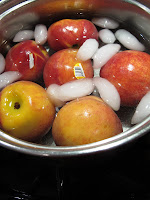In a "celebration" of past Daring Baker and Daring Cook challenges, Lisa challenged all of us to search through the Daring Kitchen archives and pick any one we'd like! The REAL challenge was picking which delicious recipe(s) to try!
I got very excited with this challenge because I wanted to make pie for last months's challenge hosted by Rachael from pizzarossa but was unable to participate. We were off on a vacation adventure and I could not figure out how to blog from an IPAD. So, I made Peach Pie for this month's challenge and it is a happy pie time over here. The peaches were calling my name at the store. I smelled their sweet scent before I even saw them. I practiced the technique of putting them in boiling water for about 30 seconds before ice water shocking them. The skins just slipped away from the pulp for the most part. I had a couple of naughty ones that required manual peeling I used the recommended crust recipe that our June host specified. I have a pie crust recipe that I have used for years but I actually prefer the recipe given for fruit pies.
Below is the recipe. Hurry to the market if you are in the summer side of the world and get some juicy peaches. If you are not, use what is in season at your spot in the world and bake yourself up a pie using this crust. You know you've been" pie"ning for one, hehehe.
Peach Pie
Crust:2/3 cup (160 ml) (150 gm) (5-1/3 oz) unsalted butter
1¾ cups (420 ml) (250 gm) (8-2/3 oz) all-purpose flour
2 teaspoon (10 ml) (10 gm) (1/3 oz) sugar
1/4 teaspoon (1½ gm) salt
3-8 tablespoons (45-120 ml) cold water
1 – 1½ kg (2¼ to 3-1/3 pounds) peaches (depending on the depth of your pie dish)
1/2 cup (120 ml) (200 gm)4 oz) light brown sugar, lightly packed (more or less to taste)
1/2 tsp ground cinnamon
1/2 teaspoon grated fresh ginger
1 Tablespoon flour
1 - 2 teaspoons (5-10 ml) (5-10 gm) white sugar for sprinkling (optional)
Filling:
1. Weigh/measure out the correct amount of butter, wrap it in foil and freeze it for at least 30 minutes.
2. Sift the flour, sugar and salt into a large bowl.
3. Using the large holes on a box grater, grate the frozen butter directly over the flour in the
bowl. Hold the butter by the foil to avoid warming it up too much and work as quickly as
possible. Using a table fork, toss the grated butter in the flour until it's all coated.
Alternatively, finely chop the butter and rub in with your fingertips, working quickly to avoid
warming it. This is best left to those lucky folk with cool hands!
4. Sprinkle 3 tablespoons (45 ml) of cold water over the mixture and mix together with the fork.
Add more water, spoon by spoon, as needed - it will depend on temperature, humidity and a
million other factors, but the finished dough should be moist and starting to come together,
but not wet. I used 7 tablespoons (315 ml). Use your fingertips to test if it's sticking together.
5. Finish by using your hands to quickly bring the dough together into a ball. Just press, don't
knead.
6. Wrap dough in plastic and refrigerate for at least 30 minutes.
1. Preheat oven to hot 220°C/425°F/gas mark 7 . Lightly grease a deep 9"/24cm ceramic or metal pie dish. Note that a dish this size results in quite a thin top crust - if you want a sturdier top which cuts more cleanly, then you should use a smaller dish so you don't need to roll it out so thinly. I like to use a glass pie plate so I can monitor the cooking of the bottom crust.
2. Take 2/3 of the pastry dough (I weighed my dough and 2/3 was about 12oz/340g) and roll out to fit pie dish, right up to the rim. Line the pie dish with it, prick all over the bottom with a fork and set aside.

3. Peel, pit and chop the peaches into large chunks and place in a bowl. How tightly you can pack them into the pie depends on how thinly they are sliced - I like them chunky
4. Sprinkle the brown sugar , spice and flour over the peaches and toss well to coat.
5. Pack the peaches tightly into the lined pie dish. The filling can come up above the rim of the dish in a mound.
6. Roll out the remaining pastry dough to fit over the peaches.
7. With a wet finger, moisten the edge of the pastry in the dish. Place the dough lid on the pie and press the edges together. Trim the edges as necessary and crimp the seam closed with your fingers or the back of a fork.
8. With a pair of kitchen scissors, cut three vents in the top of the dough. You can either cut leaf shaped vents and use the pieces you removed to fashion decorative leaves, or you can cut straight vents and use any pastry trimmings to fashion decorations as desired. Moisten the back of the decorations with a wet finger and gently press onto the top of the pie.
9. Glaze the top of the pie with a beaten egg or milk, then sprinkle the top with a little white sugar.
10. Place pie dish on a baking sheet and put it into the center of the oven. Bake for 20 minutes, then reduce heat to moderate 180°C/350°F/gas mark 4 and bake for a further 30 minutes. The top should be light golden brown. The bottom should be golden brown as well.










